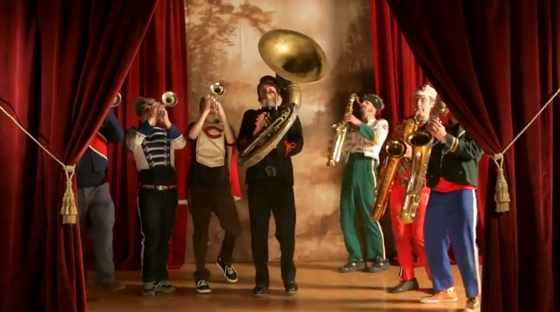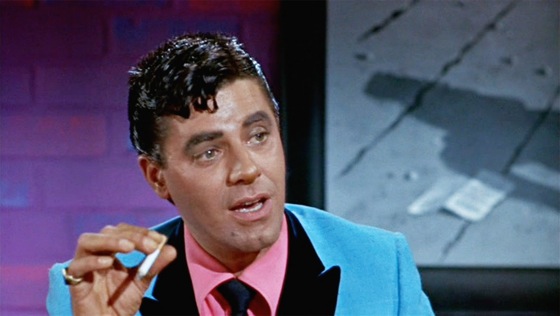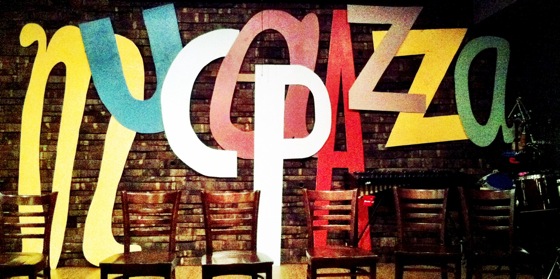| « Pulling Strings: For classical music in Chicago, you got a guy - April 2013 | Contest: Jamie Lidell @ Lincoln Hall, 4/6 » |
Interview Thu Apr 04 2013
Inspired Clowning: An Interview with Mucca Pazza's Mark Messing

A still from the video for "Boss Taurus." Sousaphonist and band leader Mark Messing (center) is filling a new role this spring for a residency at Revolution Brewing.
How long have humans sat in chairs? A very long time, Mark Messing concedes. It's not a new idea. But it is new for Mucca Pazza, Chicago's resident punk marching band.
The group is known for selling out rock venues and providing an eccentric and spirited soundtrack to a number of local summer events, often when Chicagoans least expect it, as if somehow twenty-odd horn players and percussionists (and don't forget the violinist, guitarist, accordion player, and cheerleaders) can just materialize out of thin air.
But in February, for the first time ever, Mucca Pazza put on a new style of shako and offered a sit-down show in the upstairs room of Revolution Brewing. The experiment seemed to work. Mucca Pazza Presents: Sitting In Chairs has become a Monday night residency and the band's opportunity to focus on new, more textural (but no less energetic) material.
On a recent Monday, it felt as if a wealthy philanthropist had founded a college on the Island of Misfit Toys and what onlookers saw before them was the inaugural graduating class of the IMT Conservatory of Music. A few days later, I met Mark Messing, Mucca Pazza's mutton-chopped bandleader and one of its many composers, for coffee at Cafe Calao in Humboldt Park to talk about this new series of performances and its extension through April.

Mucca Pazza sits its collective butt down in chairs while Mark Messing conducts the wacky ensemble. Catch the show any Monday in April for only $8. (Photo: Jane Kohlman Dietrich.)
Gapers Block: How did the idea come about? Did Revolution approach you guys about doing this, or did Mucca Pazza come up with the concept and shop it around?
Mark Messing: We came up with the idea. We wanted to explore a different construct. We have the marching-band construct that involves moving and playing at the same time, which has a great feel, and it's really fun to do that — you discover things about the music that way that you don't when you're sitting in a chair — but the tradeoff is you don't have as much precision in the music. And it's harder to pull off. So we wanted to do something where we could explore a little more range in the music, a little more difficulty and dynamics. Different colors.
Then I thought it would be interesting to take this other classic construct, of an orchestra sitting in chairs, and see what it feels like. Experiment with it a little bit.
GB: Did you have a venue in mind?
MM: I really wanted an old community center or a union hall, something where there's a kitchen and a dance floor and chairs. Kind of homey. The spirit of the upstairs at Revolution is similar to that. And they have a lot of community events in that room; they've done a lot of benefits for local organizations. So it has a kind of community feel. It's small, has nice acoustics so we don't use any microphones. It's also nice to do it somewhere where there's food and beer. Plus we're friendly. We're regular customers.
GB: Did it take any persuading at all? Or were they gung ho as soon as you approached them?
MM: They were ready for it. They were very excited. I think they wanna have art in that room but haven't had a chance to program it yet. They've been very generous. Also, times are tough. Sometimes you want to look around where people are successful, and think, how can I be a part of that? We're hoping some of their golden touch will rub off on us. The King Midas touch.
GB: When you started putting the concept together, where did you look for ideas? What influenced Sitting In Chairs?
MM: We were very inspired by Jerry Lewis, the Jekyll and Hyde movie... what's the name? The Nutty Professor! The nutty professor takes a potion and turns into Buddy Love, who's a very swank playboy guy who sings like Frank Sinatra. That split character is also backed by a big band. His style of clowning is inspirational. And his musicality, his dancing. It's amazing.
Also we were really inspired by [Phillipina] "Pina" Bausch, the choreographer. Her troupe was together for decades and decades, so they became a very close-knit community and developed a style that was well coordinated, in terms of group behaviors and looking like a group, but all of the individuals are also highly individual and have really engaging characters. So they can perform choreography as a group, but they don't lose their personalities in that conformity.

Mucca Pazza looked to Jerry Lewis's Buddy Love character from 1963's The Nutty Professor for inspiration for its Sitting In Chairs concept.
GB: I recognized a few tunes from Safety Fifth, but most were new to me. How much brand new material are you performing on these Mondays?
MM: About 90 percent.
GB: Wow.
MM: Yeah. So the moment we decided to do it, I asked everyone to start writing music, to think about it as something [they] maybe weren't able to do when we had to worry about moving and playing loud. Everybody's writing material like crazy. We've got another ten songs in the pipeline. We may have to go to two sets before the run is over (laughs).
GB: How much changes Monday to Monday? Is the show pretty standard?
MM: It's a slow change. We want to repeat the songs a few weeks at a time to dig into them and explore the dynamics....It takes a while for everybody to not just learn their part but to learn everyone's part, to understand how [they] fit.
GB: A number of you compose. How did the writing process change when you were writing for a specific venue and this concept? Did you talk to some of the others while they were in process with their stuff?
MM: Yeah. I asked them to explore textures they wouldn't normally explore. Because when you're doing the marching thing, you want have a lot of volume sometimes, a lot of unison parts, so they're featuring the quiet instruments a little more, the accordion, guitar, saxes. I asked them to look at different time signatures, something that's maybe difficult to march to —
GB: Yeah, was there something in five?
MM: Close. It was, um, it would've been Larry Beers's piece, let's see... (counts) 11/8. It's kind of like you're waltzing in an elevator and you keep running into the wall and having to start over again.
GB: There's something about what you do that delights people. That seems to be true of the performers as well, you seem to be having a great time. Has that always been one of the goals of Mucca Pazza, to have fun and make sure that translates to the audience?
MM: The goal, internally, has been to have fun. So we never said at the beginning, you have to come to every rehearsal or you can't be in the band. We just said, if it's fun you'll keep coming. There's not a real test to ensure that that transfers to an audience, but it's the internal goal. But I guess it does.
GB: Did you have any doubts that it would [transfer] in this new setting?
MM: I thought that the feeling would be different, because the focus of attention is different. Maybe it's about different kinds of joy, a deeper kind of joy. There's a quiet joy, and there's a silly, jumping-around joy. So I think we're discovering what that focused, deeper joy is. It's easy if you're moving around — you know exercise releases endorphins, and music has its rewards too, so when you put the two together it's like crack for nerds.
We wanted to take the energy of the physical movement and remember it, bring it to the music when we're sitting still.
GB: Well, sitting still might be an exaggeration. How has it been different for you, stepping out of the band and taking on this conductor role?
MM: It's really great. First of all, it's a very lucky position to be in to hear everything equally — it's the best mix in the house. It's also a chance to explore some of those things we were talking about, tempo, dynamics, and to direct those things to happen more intentionally. I started watching a lot of conductors on YouTube and watching their styles and reading about what conductors try to get out of orchestras. [Daniel] Barenboim has some great things to say about bringing something out of silence, and also that idea of teaching an orchestra to hear the piece, which is a lot more than just saying those words. It's actually really learning the piece.

The setup at Revolution, where the band mostly stays in its seats. (Photo: Yvonne Holden.)
GB: You extended through April. Was that exciting for the group?
MM: It means more new material. A few more pizzas, some more beer (laughs). But definitely the new material is exciting. People are excited to bring in new music and hear it. Sometimes when you're in college you can write music and hear it because you've got an orchestra around all the time and a lot of students who will read your stuff. But after that, it can be hard to get a group together, a large group to read music that you've composed. So we're trying to take advantage of this time and having this band of 25 people.
Mucca Pazza Presents: Sitting In Chairs is every Monday through April at Revolution Brewing, 2323 N. Milwaukee Ave. Doors open at 8pm. Tickets are $8.
















Alexi / April 27, 2013 2:46 AM
"...(and don't forget the violinist, guitarist, accordion player, and cheerleaders)..."
You wrote that and then forget the mandolin player.